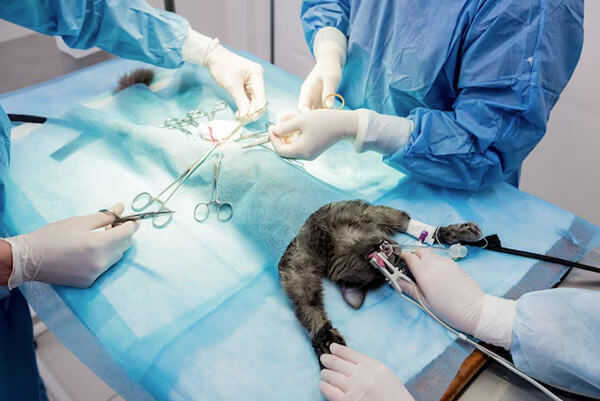
Urinary obstruction is a blockage of the flow of urine out of the body. Obstructions are often the result of plugs of inflammatory material or small calculi or “stones” that have formed in the kidneys and have passed down into the bladder and become lodged in the urethra(the tube by which urine is drained from the bladder out of the penis or urethral opening). The cause of the inflammatory materials and stone formation is not well understood, though viral infections and diet may play a role. Male cats can easily develop obstruction of the urethra and it is a somewhat common occurrence for them, because the urethra/penis is much smaller in male cats as compared to female cats. Risk factors for urinary obstructions include: being overweight or neutered, living in a dry environment, stress in the household, having congenital defects of/or having trauma to the urethra, certain diets, low water intake or dehydration, and drinking water with high mineral content.
Besides being extremely painful, urinary blockages can lead to potentially irreversible kidney damage, heart arrhythmias, and bladder or urethral rupture. If left untreated urethral obstructions usually prove to be fatal in 3-6 days. If treated aggressively, 99% of the cats affected survive.
The accepted standard for treatment is to place a urinary catheter under sedation or anesthesia in order to remove the blockage, and allow a source for urine to leave the body. The patient is then hospitalized and treated with large amounts of IV fluids, pain medications, and anti-spasm medications for the urethra. The urinary catheter is left in for 24 hours past when the urine becomes clear of the presence of blood. At this point, the urinary catheter is then removed and the patient is kept on fluids for another 24 hours and the patient is monitored for urine production and/or re-obstruction. 50-75% of cats treated in this fashion never re-obstruct. Of the cats who do re-obstruct, 75% of them will re-obstruct in the first 48 hours after the urinary catheter was removed.
Urinary catheterization carries risks; however, if they are not unblocked the general outcome of this condition is fatal. In a small percentage of cases the urethra can tear while placing a urinary catheter, also there is a small percentage of cases where a urethral catheter is unable to be passed. In the event of the urinary catheter not being able to be passed, a Perineal Urethrostomy surgery is required at that time (see more information on this below). Another temporary option for relief of the pressure in the bladder is cystocentesis. This option only provides temporary relief and will not generally resolve the condition.
If re-obstruction occurs, there are three treatment options: Replace the urinary catheter, this time leaving it in twice as long as it was left in on the first attempt, to proceed with surgery at this time if doctor deems it necessary, or a humane euthanasia.
Perineal Urethrostomy Surgery
This is a very invasive surgery, where the penis is removed and thus shortens the urethra, and in essence gives the male cat a urethral opening the size of a female cat to assist in alleviating the issue of re-blocking. This surgery has up to an 86% success rate; however, it does have risks. Cats that have undergone a P.U. surgery have a much higher risk for urinary tract infection for the remainder of their life. Other complications include: re-obstruction despite the surgery being performed, urethral stricture (where the urethrostomy site closes and scars as the tissues heal and the pet will then have difficulty urinating again, and thus may necessitate additional surgery which may not be successful), and urinary or fecal incontinence for life. Generally this surgery is not recommended unless a patient has experienced multiple obstructions.
If there are actually bladder stones and not just grit or debris in the bladder seen on x-ray or ultrasound, a surgery that may be offered would be a Cystotomy. This surgery involves cutting into the bladder itself and removing the stones to prevent obstruction.
Treatment options
- Recommended initial treatment: 2-4 days hospitalization & Diagnostics
